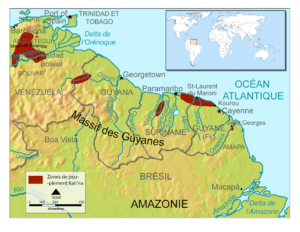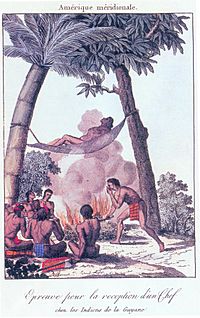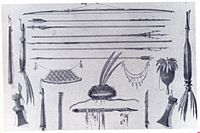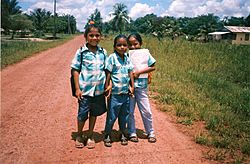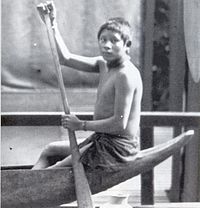Kalina people facts for kids

Kalina schoolchildren from Bigi Poika, Suriname, 2002.
|
|
| Total population | |
|---|---|
| 21,714 | |
| Regions with significant populations | |
| 4,000–5,000 | |
| 2,500 | |
| > 475 | |
| 3,000 | |
| < 100 | |
| Languages | |
| Kali'na Various local languages |
|
| Religion | |
| Animism, Christianity | |
| Related ethnic groups | |
| Island Caribs | |
The Kalina people, also known as the Caribs, are an indigenous group living in the northern coastal areas of South America. Today, many Kalina live in villages along rivers and coasts. You can find them in Venezuela, Guyana, Suriname, French Guiana, and Brazil. They speak a Cariban language called Kali'na. They might be connected to the Island Caribs from the Caribbean, but their languages are not the same.
Contents
What's in a Name?
For a long time, people from Western countries called the Kalina by names like "Caribs." This name came from the Spanish word Caribe. In French, they were called Galina, and in Dutch, Karaïeb.
However, the Kalina people call themselves Kalina or Karìna. There are different ways to spell this, like Kali'na or Kariña. Sometimes, they call themselves Kali'na tilewuyu, which means "true Kalina." This helps them stand out from people who are part Kalina and part Maroon. The name "Kalina" has only recently become common in books and articles. Many older sources still use "Caribs."
A Look at Kalina History
Before Europeans arrived, the Kalina people did not have a written language. Their history was passed down through stories, myths, and legends. Elders would tell these tales to younger generations.
For many years, few Europeans studied the history of these groups. Interest grew again in the late 20th century. That's when some French researchers and the Kalina people themselves began to share their history.
Because of this, information about the Kalina's past can be hard to find and might not be complete.
Life Before Columbus
Since there are no written records, archaeologists help us learn about the past. They have found many ancient sites in the Kalina lands. Some of these sites are over two thousand years old. This shows that indigenous people have lived here for a very long time.
Before 1492, the Kalina lived along the coast. This area stretched from the mouth of the Amazon River to the Orinoco River. They shared this land with the Arawak people. The Kalina often traveled by land and sea. They visited family, traded goods, and found partners for marriage. They even traveled to the Essequibo River (in modern-day Guyana). There, they collected special red stones called takuwa. Kalina women used these stones to polish their pottery.
European Arrivals
The Palanakiłi Come
When the Kalina first met Europeans, they thought they were spirits from the sea. They called them Palanakiłi, a name they still use for white people today.
The arrival of Europeans had a big impact. Like many other indigenous groups, the Kalina population dropped sharply. This was due to violence from European soldiers. Also, new diseases brought by Europeans caused many deaths. The Kalina's immune systems were not ready for these new viruses and bacteria.
Kalina People in Paris
In the late 1800s, World's Fairs were very popular in Europe. Countries showed off their wealth and cultures from their colonies. While Paris Fairs didn't have "Amerindian villages," people were very curious. So, Kalina people were brought to Paris twice. They were shown to the public at the Jardin d'Acclimatation as a curiosity.
The 1882 Visit
In July 1882, fifteen Kalina people went to Paris. They were all from one family living in Sinnamary and Iracoubo. They called Paris Pau:wa, meaning "The Land of the Whites." They stayed in huts on the lawn of the Jardin d'Acclimatation. Their trip lasted four months. Three months were spent in Paris, and one month was for the boat journey there and back. A Creole person went with them to help communicate. A photographer named Pierre Petit took several pictures of them.
The Kalina Today
Where Kalina People Live
The part of South America where the Kalina live is not very crowded. However, the Kalina are a small group in most countries. They are only a majority in a few very quiet areas. Their current homes cover only a small part of the land they lived on before Columbus arrived.
- In Brazil, many Kalina live in São José dos Galibi. This village was started in 1950 by families from the Mana River region. It is across the Oyapock River from Saint-Georges in French Guiana. You can also find Kalina people in Macapá, the capital of Amapá, and in Belém, in Pará.
- In French Guiana, many Kalina still live in their traditional lands. This is the area between the Maroni and Mana rivers. Important communities include Awala-Yalimapo, where they are the majority. They also live in Saint-Laurent-du-Maroni, Mana, and Iracoubo. Some also live in the Amerindian village of Kourou and on the island of Cayenne.
- In Suriname, many Kalina live on the left bank of the Maroni River. They also live along the banks of the Coppename River.
- In Venezuela, which has the largest number of Kalina, they live in two main areas. These are the llanos of the Orinoco river valley and the Cuyuni River valley. Part of the Cuyuni River valley is in Guyana.
Kalina Music
Kalina music mostly uses percussion instruments. Their sanpula (or sambula) is a large drum. It has two animal skins stretched over its ends. These skins are held tight with ropes. The drum is played with a mallet. They also have two types of maracas. These are called a kalawasi (or kalawashi) and a malaka.
The kuwama is their traditional flute. It is still made, but European flutes are becoming more common. They also have a clay horn called a kuti.
Kalina Language
The Kali'na language is part of the Cariban languages family. Today, over 10,000 people still speak it. They live along the coast from Venezuela (about 5,000 speakers) to Brazil (about 100 speakers). This includes Guyana (475 speakers), Suriname (2,500 speakers), and French Guiana (3,000 speakers).
Because many people still speak Kali'na, it is one of the Amazonian languages most likely to survive. Some efforts have been made to write down the language in Guyana. However, creating one standard way to write Kali'na is hard. This is because different countries have used different writing styles. These styles have been influenced by Spanish, Portuguese, Dutch, French, and English. For example, there are nine different ways to write the name "Kali'na" itself! So, Kali'na remains mostly a spoken language.
See also
 In Spanish: Pueblo kali'na para niños
In Spanish: Pueblo kali'na para niños


